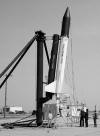March 1958 Radio-Electronics
 [Table
of Contents] [Table
of Contents]
Wax nostalgic about and learn from the history of early electronics.
See articles from Radio-Electronics,
published 1930-1988. All copyrights hereby acknowledged.
|
 Echo 1 was put into orbit on August 12, 1960. This article
was written 2½ years earlier in 1958 by Radio-Electronics magazine editor Hugo Gernsback.
A technology visionary and prolific inventor and writer, Mr. Gernsback astutely
outlined the vast number of advantages that had already been and would in the future
be afforded the science community by virtue of a satellite's perspective from space.
Two of the Soviet Union's Sputnik
satellites (the third launched in August of 1958) had revealed the Echo 1 was put into orbit on August 12, 1960. This article
was written 2½ years earlier in 1958 by Radio-Electronics magazine editor Hugo Gernsback.
A technology visionary and prolific inventor and writer, Mr. Gernsback astutely
outlined the vast number of advantages that had already been and would in the future
be afforded the science community by virtue of a satellite's perspective from space.
Two of the Soviet Union's Sputnik
satellites (the third launched in August of 1958) had revealed the
  surprisingly
irregular shape and gravitational influence of the Earth, information about the
upper atmosphere, and aspects of space environment effects on radio communications.
America was scrambling to catch up. Gernsback and others postulated the configuration
of active relay transceivers powered by solar cells and storage batteries, satellite-based
television and radio, navigation, and more. Interestingly, at least in this installment
no mention was made of weather observation or military uses. Gernsback's many electronics
magazines and books performed a significant service to the space communications
field in addition to his contributions to commercial and amateur radio and electronics.
Trivia: The 100-foot diameter inflatable metallic-film passive Echo 1 satellite
was manufactured by breakfast cereal maker General Mills. surprisingly
irregular shape and gravitational influence of the Earth, information about the
upper atmosphere, and aspects of space environment effects on radio communications.
America was scrambling to catch up. Gernsback and others postulated the configuration
of active relay transceivers powered by solar cells and storage batteries, satellite-based
television and radio, navigation, and more. Interestingly, at least in this installment
no mention was made of weather observation or military uses. Gernsback's many electronics
magazines and books performed a significant service to the space communications
field in addition to his contributions to commercial and amateur radio and electronics.
Trivia: The 100-foot diameter inflatable metallic-film passive Echo 1 satellite
was manufactured by breakfast cereal maker General Mills.
Satellite Electronics
Hugo Gernsback, Editor
... Electronics, the Essence of Satellites ...
Since the advent of the Soviet man-made satellites, on Oct. 4, 1957, we have
begun to realize the great importance of these small moons. It is quite certain
that they are here to stay and that in the future the sky will be populated by a
multitude of them in every conceivable size and various shapes. These miniature
worlds are but he stepping stones to outer space and will be the direct means of
enriching our scientific knowledge in every direction.
We have already learned more about the exact shape of the earth from information
given us by the satellites than from all previous study. Gravitation, cosmic and
other radiation, meteorites and their density in space, meteorology - -to name only
a few, will all give up many of their secrets thanks to present and future sputniks.
And most of these invaluable answers will come by electronic means.
Electronic telemetering from these satellites will be the chief method of unlocking
a vast array of new knowledge, To mention only one recent important scientific conclusion,
let us consider weightlessness.
Since 1911, the present writer has maintained, along with other scientists, that
the state of weightlessness had no adverse effect on man and was not deleterious
to him. Others were vociferous in their directly opposite beliefs. As it is impossible
on earth to create a state of human weightlessness - except for a few seconds -
no conclusions could be reached until very recently. The answer then came via telemetering
from Sputnik 2. The official Russian magazine Soviet Aviation stated that weightlessness
in space had no effect on the dog passenger and that in fact satellite No.2 had
solved the problem of the puzzle of the effect of weightlessness in space on living
entities. Said the magazine:
"The analysis of the dog's pulse, blood pressure and respiration led to the extremely
important conclusion that no harm comes to a living organism in a condition of weightlessness."
As newer, larger and better-equipped satellites are launched, the answers will
come at an ever-faster tempo. For one thing, most future satellites will not go
dead and stop transmitting in a few weeks, as did Sputniks 1 and 2. They are certain
not to be equipped again with primary batteries, which are soon exhausted. We will
have light-weight storage batteries coupled to solar cells which will charge them
continuously when the satellite is in the sun. Half the time, when the moonlet is
in the shadow of the earth, the storage batteries take over. The arrangement will
be such that the solar cells will always provide more energy than is used up. To
keep the accumulators from overcharging, an automatic cutout is provided. Thus the
satellite will always have electrical power, 24 hours a day, for the years-long
life of the storage batteries. Even after the latter wear out, the satellite will
still be able to transmit when in full sunlight, i.e., roughly 50% of the time.
Solar cells are ideally suited for powering satellite transmitters. Indeed, as we
pointed out in our January, 1958, issue, solar cells work far better out in space
than on earth. With no atmosphere to contend with, 30% to 35% more solar radiation
can be utilized. Furthermore, the voltage of the solar cells increases considerably
in below-zero temperature.
World-wide television and radio broadcasts via satellites seem assured for the
future, in the interest of world peace and better understanding between the peoples
of the world. All that is needed are four or more small 6- to 10-foot satellites
circling several thousand miles above the earth. They revolve equidistantly, in
such a manner that one satellite can always "see" the one ahead and the one behind.
Let us assume that via a transmitter at Washington D.C., the United Stares wished
to send radio and TV programs to cover the entire world continuously. The Washington
station beams the signals to satellite A, when it is in sight. Satellite A then
relays them to satellite B in space. B relays to satellite C and C to D. B, C and
D in turn beam the relays to earth, thus covering the entire planet (see diagram
on "page 125). In the meanwhile, satellite a moves on and soon "sets" over Washington.
At the same time, moon D "rises" and Washington will beam its signals to D, until
D sets. Thus the four satellites will insure continuous world-wide broadcasts. The
quality will be good, too, because there will always be a moonlet "in sight" on
earth. We are fully aware that in an undertaking of this type a few engineering
points would have to be solved, such as the Doppler effect of the speeding satellite
transmitters, zero-beat heterodyning between the transmitters, and a few other problems.
We believe, however, that these problems offer no great difficulties today.
Rocket experts will also question the feasibility of placing four satellites
in the same orbit, equidistant from each other. In itself this would be a formidable
feat - even for the Russians, considering present-day rocket science technique.
But it is strictly feasible with the help of electronics. Our four satellites (and
this goes for other future ones) must themselves be equipped with small "correcting"
rockets, Then, if a satellite is off orbit or off course, the correcting rocket
is fired from earth by electronic impulse. Thus the satellite can be maneuvered
until it is where it should be. Its speed can also be increased or decreased.
Unpleasantly enough, future satellites can also be formidable weapons. Warheads,
with which they could be equipped, could be fired electronically from earth. This
is not a simple feat today for many reasons. Because the satellite is speeding at
more than 5 miles a second, the aiming, the exact angle, the time of firing all
must be extremely and fantastically accurate. Thus a tenth of a second early or
late will place the bomb hundreds of miles off target. This is also true of the
aiming angle. A tenth of a degree off will miss the target by hundreds of miles.
While talking of satellites, radio amateurs will welcome the news that since
Jan. 14, 1958, the Army Signal Corps has been bouncing radio waves off the moon
on even-numbered nights when the moon is up. The signals are on the frequency that
will be used by our satellites - 108 mega-cycles. This will be of great help to
all official satellite tracking stations and those who wish to track our future
moonlets and to get used to listening in on that frequency. - H.G.
World-Wide Television
The above two diagrams refer to Hugo Gernsback's editorial on page 33. The top
diagram shows how signals originating from earth are transmitted to a system of
four earth satellites orbiting equidistance from each other. In such a system, television
programs originating from a point in the US can be seen simultaneously at practically
any point on earth 24 hours a day. The upper illustration shows a plan view looking
down on the earth from space. The bottom view, a perspective of the four satellites
as they gravitate around the earth about 1,000 miles up.
Posted April 9, 2020
(updated from original post on 11/13/2018)
|











